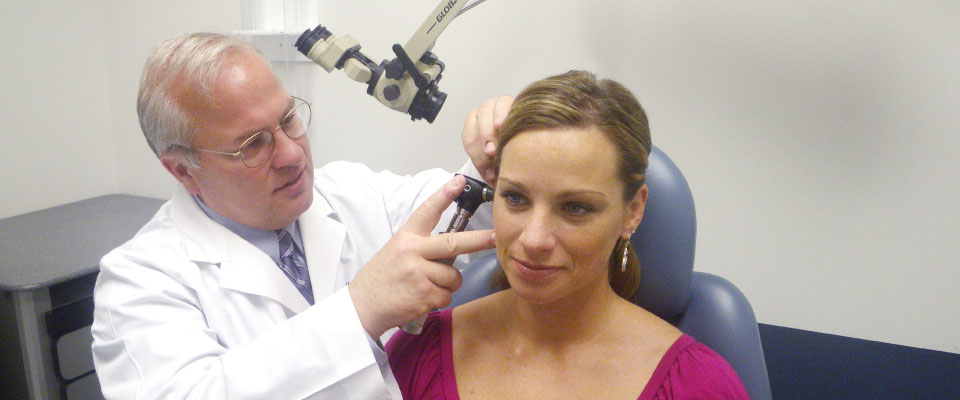Tonsillitis
Tonsillitis, also described as pharyngitis, refers to inflammation of the pharyngeal tonsils, which are lymph glands located in the back of the throat that are visible through the mouth. Typically, tonsillitis happens suddenly (acute). Some patients experience recurrent acute episodes of tonsillitis, while others develop persistent (chronic) tonsillitis.
Tonsillitis is often caused by viral or bacterial infection (see “What Causes Tonsillitis?” below). Tonsillitis is common in children; most children in the United States experience at least one episode. Antibiotics help treat bacterial tonsillitis, and have significantly reduced complications such as rheumatic fever, a noncontagious acute fever that causes inflammation, especially of the heart, blood vessels, and joints.
What Are the Symptoms of Tonsillitis?
Common symptoms include fever, sore throat, and swollen lymph nodes, but the type of tonsillitis determines what symptoms may occur.
Acute tonsillitis—Tonsillitis most often occurs in children, but rarely in those younger than two-years-old. Symptoms of acute tonsillitis include:
- Fever
- Sore throat
- Bad breath
- Difficulty swallowing (called dysphagia)
- Painful swallowing (called odynophagia)
- Dehydration
- Tender lymph nodes in the neck
- Mouth breathing, snoring, or sleep apnea
- Tiredness, lethargy, and malaise
- White patches, pus, and/or redness of the tonsils
A fine red rash over the body suggests that scarlet fever may be complicating a case of tonsillitis. These symptoms usually clear up in three to four days, but may last up to two weeks, even with therapy. Some patients experience recurrent actue tonsillitis in which symptoms return shortly after completing antibiotic therapy.
Chronic tonsillitis—Symptoms of chronic tonsillitis include:
- Chronic sore throat
- Bad breath
- Tonsil stones (debris that has collected on your tonsils)
- Persistently tender lymph nodes in the neck
Peritonsillar abscess—Peritonsillar abscess is a severe case of tonsillitis in which an abscess or pocket of pus develops around the tonsil. It is usually found in adolescents and adults, but can occur occasionally in children. Symptoms of peritonsillar tonsillitis include:
- Fever
- Severe throat pain
- Drooling
- Difficulty opening the mouth (called trismus)
- Muffled voice quality
- One tonsil may appear larger than the other
What Causes Tonsillitis?
Up to 70 percent of cases of acute tonsillitis are caused by viruses, which often include adenoviruses, influenza viruses, parainfluenza viruses, enteroviruses, and Mycoplasma. Children and young adults infected with the Epstein-Barr virus (EBV), with infectious mononucleosis, may develop tonsillitis. Herpes simplex virus, cytomegalovirus, and the measles virus have also been associated with tonsillitis.
Bacteria cause 15 to 30 percent of tonsillitis cases. Group A beta-hemolytic streptococcus (GABHS) is the most common bacteria associated with tonsillitis. Bacterial tonsillitis is often referred to as strep throat. It is believed that GABHS is spread through airborne droplets when someone who is infected coughs or sneezes, or through shared food or drinks. Individuals are most infectious early in the course of the disease.
What Are the Treatment Options?
Patients with symptoms of tonsillitis should see their primary care provider or an ENT (ear, nose, and throat) specialist, or otolaryngologist. To determine whether a patient has a viral or bacterial infection, a doctor will typically swab the tonsils or pharynx (rapid strep testing). However, false negatives can occur with this test, so it is recommended that doctors obtain a throat culture in patients with negative rapid strep testing but who also show symptoms of streptococcal disease. Patients with a throat culture that is positive for GABHS, but without tonsillitis symptoms, are likely strep carriers.
Viral tonsillitis usually gets better without additional treatment. Hydration and pain control are important, and hospitalization may be required in severe cases, particularly when a patient becomes dehydrated or has an airway obstruction.
Bacterial tonsillitis is usually treated with antibiotics, which help GABHS tonsillitis get better faster, and prevent complications such as rheumatic fever. Common antibiotics used to treat tonsillitis include penicillins, cephalosporins, macrolides, and clindamycin.
In certain situations determined by your ENT specialist, surgery may be recommended to remove the tonsils. Typically, children who have seven episodes of tonsillitis in one year, or five episodes per year for two consecutive years, or three episodes per year for three consecutive years, are considered candidates for tonsillectomy. If a patient has a severe case of tonsillitis—peritonsillar abscess—surgery may be needed to drain the abscess around the tonsil.
What Questions Should I Ask My Doctor?
- What are the common symptoms of tonsillitis?
- How do I know if my child is a strep carrier?
- What tests are typically performed in a child with suspected tonsillitis?
- When can my child return to school and activities following a strep throat infection?
- Do all cases of tonsillitis require antibiotic therapy?
- When is surgery necessary for the treatment of tonsillitis?
Reference
Tinnitus
Over 50 million Americans have experienced tinnitus, or ringing in ears, which is the perception of sound without an external source being present. About one in five people with tinnitus have bothersome tinnitus, which negatively affects their quality of life and/or functional health. Tinnitus may be an intermittent or continuous sound in one or both ears. Its pitch can go from a low roar to a high squeal or whine, or it can have many sounds.
Persistent tinnitus lasts more than six months. Prior to any treatment, it is important to undergo a thorough examination and evaluation by an ENT (ears, nose, and throat) specialist, or otolaryngologist, and an audiologist. Your understanding of tinnitus and its causes will enhance your treatment.
What Are the Symptoms of Tinnitus?
Tinnitus is not a disease per se, but a common symptom, and because it involves the perception of hearing sound or sounds in one or both ears, it is commonly associated with the hearing system. In fact, various parts of the hearing system, including the inner ear, are often responsible for this symptom. At times, it is relatively easy to associate the symptom of tinnitus with specific problems affecting the hearing system; at other times, the connection is less clear.
Common symptoms of tinnitus include:
- Constant high- or low-pitched ringing in ears
- Intermittent or constant roaring in ears
- Pulsation or beating noises in ears
- Associated with or without hearing loss
What Causes Tinnitus?
Most tinnitus is primary tinnitus, where no cause can be identified aside from hearing loss. Secondary tinnitus is associated with a specific underlying cause that may be treatable. Your ENT specialist will help you distinguish whether your tinnitus is primary or secondary.
Tinnitus may be caused by different parts of the hearing system. The outer ear (pinna and ear canal) may be involved. Excessive ear wax, especially if the wax touches the ear drum, causing pressure and changing how the ear drum vibrates, can result in tinnitus.
Middle ear problems can also cause tinnitus, including middle ear infection (common) and otosclerosis (uncommon), which hardens the tiny ear bones or ossicles. Another rare cause of tinnitus from the middle ear that does not result in hearing loss is muscle spasms in one of the two tiny muscles in the ear. In this case, the tinnitus can be intermittent and sometimes your examiner may also be able to hear the sounds.
Most subjective tinnitus associated with the hearing system originates in the inner ear. Damage and loss of the tiny sensory hair cells in the inner ear (that can be caused by different factors such as noise damage, medications, and age) may also be associated with tinnitus.
One of the preventable causes of tinnitus is excessive noise exposure. In some instances of noise exposure, tinnitus can be noticed even before hearing loss develops, so be careful to take special precautions to protect your ears and hearing in noisy environments.
Medications can also damage inner ear hair cells and cause tinnitus. These include both non-prescription medications such as aspirin and acetaminophen, when taken in high doses, and prescription medication including certain diuretics and antibiotics. As we age, the incidence of tinnitus increases.
Tinnitus may also originate from an abnormality in, or near, the hearing portion of the brain. These include a variety of uncommon disorders such as damage from head trauma, or a benign tumor called “vestibular schwannoma” (acoustic neuroma).
Tinnitus that sounds like your pulse or heartbeat is known as “pulsatile tinnitus.” Infrequently, pulsatile tinnitus may signal the presence of cardiovascular disease, narrowed arteries, or a vascular tumor in your head and neck, or ear. If you are experiencing this type of tinnitus, you should consult a physician as soon as possible for evaluation.
Finally, non-auditory conditions and lifestyle factors can exacerbate tinnitus. Medical conditions such as temporomandibular joint arthralgia (TMJ), depression, anxiety, insomnia, and muscular stress and fatigue may lead to, or exacerbate, tinnitus.
What Are the Treatment Options?
When you are evaluated for tinnitus, the first thing the doctor will do is obtain a complete history and perform a thorough, targeted physical examination. If your tinnitus is one-sided (unilateral), associated with hearing loss, or persistent, a hearing test, or audiogram, should be ordered. There is typically no need for radiologic testing (X-ray, CT scan or MRI scan) unless your tinnitus is pulsatile or associated with uneven, asymmetric hearing loss or neurological abnormalities. Your doctor will determine how bothersome your tinnitus is by asking you certain questions or having you complete a self-assessment questionnaire.
Although there is no one “cure” for tinnitus, there are several options available that can help patients with tinnitus. Because tinnitus is relatively common and not always worrisome, not all patients need an evaluation. If your ENT specialist finds a specific cause for your tinnitus, they may be able to offer specific treatment to eliminate the noise. This may include removing wax or hair from your ear canal, treating middle ear fluid, treating arthritis in the jaw joint, etc. For many patients who have experienced tinnitus for less than six months, its natural course is to improve over time, and most people do not go on to have persistent, bothersome tinnitus.
Some patients with hearing loss and tinnitus have improvement with the use of hearing aids, with or without built-in ear-level maskers. Sound therapies that involve simple things like background music or noise or specialized ear-level maskers may be a reasonable treatment option. The effects of tinnitus on quality of life may also be improved by cognitive behavioral therapy (CBT) counseling, which usually involves a series of weekly sessions led by a trained professional.
Tinnitus can be so bothersome in some patients that it causes depression or anxiety; additionally, in a patient with depression and/or anxiety, it may be very difficult to tolerate tinnitus. Consultation with a psychiatrist or psychologist with treatment directed to the underlying condition can be beneficial.
Routine prescription of medications including antidepressants, anticonvulsants, anxiolytics, or intratympanic injection of medications is not recommended for treating tinnitus without an underlying or associated medical problem that may benefit from such treatment.
Dietary supplements for tinnitus treatment are frequently advertised on the internet, television, and radio, but there is no evidence that supplements such as ginkgo biloba, melatonin, zinc, Lipoflavonoid, and vitamin supplements are beneficial for tinnitus.
Acupuncture may or may not be help your tinnitus; there are not enough quality studies of this type of treatment to make a recommendation. Transcranial magnetic stimulation is a new modality, or therapeutic agent, but its long-term benefits are unproven and cannot be recommended for treating tinnitus at this time.
What Questions Should I Ask My Doctor?
- Can other people hear the noise in my ears?
- Why is my tinnitus so loud at night?
- Can my child be at risk for tinnitus?
Thyroid Nodules
The thyroid is a butterfly-shaped gland located at the base of the front of the neck. It produces thyroid hormone, which controls your metabolism, temperature regulation, and keeps your muscles and organs working properly. Diseases of the thyroid, whether functional (hypothyroidism, hyperthyroidism) or structural (nodule, goiter, cancer), occur very commonly.
A nodule is an area of abnormal growth within the thyroid gland. Some people have a single nodule while others have multiple nodules within the gland. Thyroid nodules, which are particularly common in women, can be tiny to very large in size.
Most thyroid nodules are non-cancerous, do not cause symptoms, and do not need any treatment. In some cases, however, because of the size, appearance (on radiology tests), or symptoms caused by the nodule, additional evaluation and treatment may be needed.
What Are the Symptoms of Thyroid Nodules?
Because many thyroid nodules are small, they may cause no symptoms. However, some nodules can cause the thyroid to grow (called a goiter), some can be overactive and lead to hyperthyroidism, and some can be thyroid cancers. If patients do experience symptoms they may include:
- A lump in the neck
- Difficulty swallowing
- Pressure in the neck
What Are the Treatment Options?
Most thyroid nodules require no treatment. Depending on the type of nodule and related symptoms, different treatment options may be appropriate. In some cases, thyroid surgery is needed.
Your endocrinologist or ENT (ear, nose, and throat) specialist, or otolaryngologist, may order or perform:
- Thyroid function tests, including thyroid stimulating hormone (TSH)
- Blood tests, or radiology examination
- An ultrasound to see the size and appearance of the nodule
- A fine needle aspiration (FNA) biopsy, which is a safe, relatively painless procedure. In this procedure, a small needle is passed into the lump, and tissue samples containing cells are taken and then sent to a pathologist for testing.
What Questions Should I Ask My Doctor?
- What are the risks of thyroid surgery?
- Is it an outpatient or inpatient procedure?
- What kind of recovery should I expect after thyroid surgery?
- What kind of a scar should I expect?
- What kind of wound care will I need to do after discharge?
- What kind of pain should I expect?
- Do I need thyroid medication after thyroid surgery?
Thyroid Cancer
The thyroid is a butterfly-shaped gland located at the base of the front of the neck. It produces thyroid hormone, which controls your metabolism, temperature regulation, and keeps your muscles and organs working properly. Thyroid cancer is very common, particularly in women. It is now one of the most common cancers found in women. Most forms of thyroid cancer are slow growing and well-treated with surgery and sometimes other therapies.
Thyroid cancers are often found within nodules that are either felt by the patient or their doctor. These nodules are also frequently found incidentally, for example, when the patient has an imaging test not related to the thyroid.
What Are the Symptoms of Thyroid Cancer?
Many patients with thyroid cancer do not report any symptoms, though the following symptoms may be present:
- Difficulty swallowing
- Voice changes
- A lump in the neck
What Are the Types of Thyroid Cancer?
There are several types of thyroid cancer including:
Papillary—This is the most common form of thyroid cancer. This type of cancer, which tends to grow slowly, has a good prognosis. It often spreads to neck lymph nodes.
Follicular—This type of thyroid cancer also typically has a good overall prognosis except when significant invasion of other tissues is present.
Medullary—This form of thyroid cancer develops from cells in the thyroid gland that are different from papillary and follicular thyroid cancers. While the prognosis with medullary cancer is not as favorable when compared with those types of thyroid cancers, it is also much less common (between five- and 10-percent of all thyroid cancers). While medullary thyroid carcinoma can be associated with several inherited syndromes, more often it occurs in patients without any family history.
Anaplastic—This is the least common type of thyroid cancer, but it is very aggressive, and the prognosis is poor. It presents as a rapidly enlarging neck mass.
What Are the Treatment Options?
A biopsy with a needle (called fine needle aspiration or FNA) may be performed based on physical exam and ultrasound, or radiographic findings. In some patients, a biopsy may show a cancer, and surgery will be recommended. In others, biopsies may be indeterminate, and a cancer diagnosis is confirmed only after surgical removal. At times, a genetic analysis may be added to the biopsy, to help further clarify the risk of cancer and guide treatment decision-making.
The primary treatment for thyroid cancer is surgery. This surgery involves removing the thyroid gland and sometimes enlarged lymph nodes. Surgical treatment is determined on a case-by-case basis and is determined by the patient’s biopsy and imaging, as well as other factors. Treatment options include:
Papillary—This type of cancer is treated with thyroid surgery and, in selected cases, radioactive iodine.
Follicular—This type of thyroid cancer is treated similarly to papillary carcinoma, with thyroid surgery and, in selected cases, radioactive iodine.
Medullary—Treatment for medullary thyroid cancer is primarily surgical. If the cancer is found to be inherited then family members of the patient may need genetic screening testing.
Anaplastic—This cancer often grows very quickly and requires a medical team comprised of several specialists to determine the best treatment plan.
What Questions Should I Ask My Doctor?
- After thyroid surgery, do I need to take thyroid medication?
- Are there any options to treat thyroid cancer after surgery?
- Can thyroid cancer spread to other parts of the body?
- Does thyroid cancer occur in men or in children?
- Can thyroid cancer recur after surgery and treatment?














